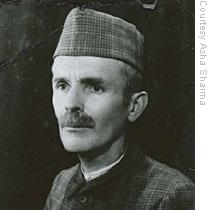
Asha Sharma was a child when her grandfather Samuel Stokes died in 1946, so she didn’t know him well. But over the years, she learned more about him and became fascinated with his story.
“Samuel Stokes belonged to a very distinguished family of Quaker heritage,” she says. “His first American ancestor, Thomas Stokes, had come to Philadelphia in 1678. When Sam was about 20 years old, he decided to go to India and work in a leper home in Simla Hills. He joined some missionary activity. His parents, of course, were worried that he would get leprosy and never return. But he was determined to go.”
Johnny Appleseed of the Himalayas
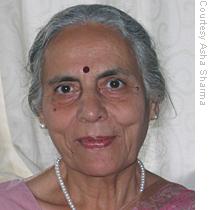
Samuel Evans Stokes came to India in 1904 as a missionary and ended up a Hindu, fighting for India’s freedom
Samuel Evans Stokes came to India in 1904 as a missionary and ended up a Hindu, fighting for India’s freedom
“He saw that people were very, very poor,” Sharma says. “They didn’t have clothes to wear. They didn’t have meals to eat. They would have tea with salt. Then he thought he maybe could try growing fruits in that area. Somehow the idea of apples came to his mind.
“In 1916, he brought the first apple trees from Philadelphia to the Simla Hills. He distributed them [the apple seeds] free to the local people and helped them to plant and nurture them. That was a start of an economic revolution in that area.”
Sharma says it wasn’t easy for Stokes to convince local farmers to start planting apple trees.
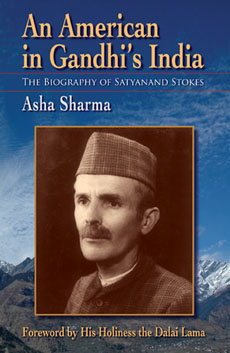
Tragedy inspires Stokes to join independence movement
What many people don’t know, though, is that Stokes had become an active member of the Indian Independence Movement, even writing a series of newspaper articles advocating the country’s freedom from foreign domination.
“C.F. Andrews, the British man, was very close friend of Mahatma Gandhi, and C.F. Andrews was a very close friend of my grandfather, Stokes,” she says. “That’s how Stokes first got connected with Gandhi. But Stokes was doing a lot of work for the people of the Hills. He was fighting the British administration against forced labor.
“It was the incident of April 1919 [The Jallianwala Bagh’s incident in Amristar in the Punjab], when there was indiscriminate shooting of about one thousand people in a garden in Punjab. That’s the time that Stokes saw the violence against the Indian people and decided to join the Indian National movement. He became very active in the Punjab. He became a member in the Punjab Provincial Congress Committee.
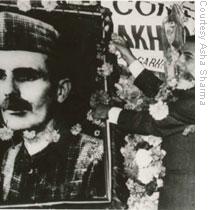
As an outspoken independence advocate, Stokes had to pay the price for what he believed in, Sharma says.
“He was arrested and put in prison for six months. He refused to be treated like a European,” she says. “You know in those days, there was a separate ward for the Europeans and a separate ward for the Indians. But he said, ‘I don’t want to have special treatment.’ Buy, anyway, he did that six months of jail sentence in Lahore, and I think that was a highlight of his life, something he was very proud of.”
Commitment to India both political, personal
That passion for equality extended to Stokes’ personal life.
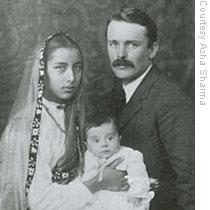
Sharma says her grandfather was a prolific writer. His journals, books and correspondence with family members and friends were a great resource as she began to write about his life. What fascinates her most, she says, is how her grandfather came to India to teach people about Christianity… and ended up staying, becoming a Hindu, and studying Indian languages and philosophies.
“I think he was really touched by the simplicity of the Indian people,” she says. “It is the openness of the Indian society and the acceptance; I think that is what makes a difference, the culture, which is thousands of years old. Those kinds of things when people go there, you welcome whoever comes to your home. 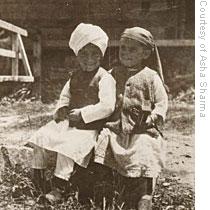
Sharma says she hopes An American in Gandhi’s Land will keep Samuel Stokes’ legacy alive. She’d like her grandfather to be remembered as a champion of freedom and equality and, of course, as the man who introduced the American Delicious apple to the Himalayas.
With kind premission from Asha Sharma, via Voice of America.




hats off to Samuel Evans Stokes
Phila. boyhood unfolds into noble India activism
By Carlin Romano
An American in Gandhi’s India
The Biography of Satyanand Stokes
By Asha Sharma
Foreword by His Holiness the Dalai Lama
Indiana University Press.
Local officials and university leaders say it’s important that more of Philadelphia’s talented young people stay here as they begin their working lives.
The city, we’re told, needs their youth, their energy, their idealism.
True enough. But sometimes the greatest gift a city can offer the world is a young person, formed in its finest traditions and beliefs, who ventures off and brings the glow of unquestioned integrity, the fire of altruism, to those who need it even more.
Satyanand Stokes (1882-1946), née Samuel Evans Stokes Jr., was such a native son. His astonishing life story, first published in India in 1999, now happily arrives home in a handsome U.S. edition.
You’ve probably never heard of Stokes, but Mohandas K. Gandhi did. And it’s not every day that the Dalai Lama writes a foreword to a book. Satyanand Stokes attracts those sorts of admirers.
At age 21, Samuel Evans Stokes Jr., the firstborn son of a Philadelphia Quaker family that stretched back to the era of William Penn, set off for India’s Simla Hills to work in a home for lepers.
Stokes initially tried to emulate St. Francis by forming a religious brotherhood. Before long, he went Indian. He took on local dress, rejected the privileges of a white Westerner, gave away his belongings, and adopted the name Satyanand.
In 1912, he married a local woman, a marriage that produced seven children. Living near Shimla, the summer retreat of the British Raj, Stokes introduced American Red Delicious apples to the Himalayas in 1916, forever changing the local economies. In 1924, he opened a school to educate the children of local farmers, putting special emphasis on the education of girls.
The new activist for concerted social action also led a successful fight against begar, a system under which local rajas and the British exploited poor, uneducated hill people by forcing them into free labor.
Later, Stokes became a leader in Gandhi’s independence movement, the only American member of the All India Congress Committee. He also ended up the only American ever imprisoned by the British (six months) for involvement in that cause. In 1932, he converted to Hinduism, in part because he detested the Christian notion of eternal punishment.
Asha Sharma, the author of this lovingly detailed and enormously moving biography, is a granddaughter of Stokes. She graduated from Columbia University’s school of journalism and served as a research associate at the University of California, Berkeley.
Her excellent combination of smooth storytelling and primary-source digging (drawing on such family material as Stokes’ 25 years of letters to his mother back here) reflects those affiliations. Sharma makes Stokes’ story alluring in both its early Philadelphia moments and its long unfolding in India.
His father, Samuel Evans Stokes Sr., was the founder of the Stokes & Parrish Machine Co., one of America’s first major elevator firms, which later merged with Otis. The family lived at 5419 Wayne Ave. in Germantown, and Sam Jr. attended Philadelphia’s Quaker Penn Charter School, and later Cornell University.
Stories of King Arthur and the Knights of the Round Table instilled in young Stokes, his granddaughter explains, powerful impulses toward justice and honor.
As a boy, he helped older people cross the road. He once gave his whole money box to a woman who came begging at the family’s door.
Later, in his adolescence, Stokes experienced a spiritual awakening that further fueled his bent toward service. Already teaching Sunday school at Germantown’s Calvary Church, he and a friend founded a boys club at the corner of Front and Ellsworth that grew into the Southwark Neighborhood House.
So when Marcus Carlton, a doctor devoted for 20 years to treating lepers in India, gave a talk in Philadelphia about his clinic’s need for workers, Stokes proved an ideal listener.
Stokes’ father offered him $500 a year for five years, sure that Sam Jr. would eventually come back and take over the family company. He never did return, except for visits.
In India, Stokes and Gandhi formed a mutual-admiration society. Writing of Gandhi in 1921, Stokes described himself as “more and more convinced that the movement which [Gandhi] has initiated calls us to the deepest and noblest in our nature.”
“It is that old call to victory by the path of utter self-renunciation, to purification by the path of self-sacrifice.”
Elsewhere, Stokes described his link to Gandhi as “the part of my life of which I am most proud.”
But if Stokes’ own writing sounds decidedly Gandhian, Sharma’s section on his boyhood shows that his heart was in the right place long before.
“If we fight with the ignoble weapons of pride and hate and prejudice,” Stokes wrote in one article, “we are undone, even if we win a sort of immoral victory. If we fight in the spirit of true nobility, God and eternal justice fight for us, and the victory is certain.”
Gandhi, for his part, praised Stokes’ campaign against forced labor, telling him, “In your efforts, I am with you with all my heart and soul.”
When the British arrested Stokes on Dec. 3, 1921, for sedition, Gandhi responded with a front-page article in his weekly journal, Young India. That Stokes, Gandhi commented, “should feel with and like an Indian, share his sorrows and throw himself into the struggle, has proved too much for the government.”
Toward the end of his life, Stokes wrote that he believed he had “kept the faith” with his Quaker ancestors.
“The struggle for right and fair play in the relations of men,” he observed, “is a fight worth fighting.” Though Stokes conceded that many of his dreams of service had met with only “imperfect realization,” he added, “yet the dreams were something.”
In the Nehru Memorial Library in New Delhi, Satyanand Stokes’ portrait hangs among those of the other leaders of India’s independence movement.
It’s a long way from Philadelphia. Roughly the distance from one heart to another.
Stoke’s falling legacy,
Vidya Stoke, wife of Lal Chand Stoke is a prominent member of the Congress and represents the himachal region, Many people do not know of her personal connection to Anand Sharma the Union Commerce Minister. Vidya Stoke’s daugther – Queenie Sharma is married to Anand Sharma’s younger brother Ashok Sharma – the rightful heir to stokes’ legacy. However due to his physically frail condition he couldn’t take up the hectic career of a politician. Anand Sharma once a petty congressworksmen took advantage of his brother’s very influential and Sonia Gandhi’s close associate, mother – in law and slowly climbed up the ladder in the congress party. In the meanwhile Ashok Sharma’s wife runs his million dollar pharmaceutical business as the CEO of the company, where Ashok is the chairman.
Mrs Vidya Stokes is not related to Mr Anand Sharma and Queenie Sharma is not Mrs Vidya Stokes daughter.
Who was the person who influenced Stokes to Sanatan Dharam ?
Some facts have not been mentioned here deliberately as they may have their vested interest.